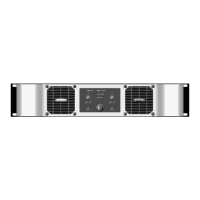3.2.6 10-kHz Square Wave 10-kHz Sq. Wave
Slew Rate Test 8-ohm Load
With an 8-ohm load on each channel, insert a 10-kHz square wave and adjust amplitude to produce an output 10V below
clipping. Observe a 50V/µS (or higher) slew rate. The output waveform should be stable with no ringing or over-shoot.
Note:
For the remaining tests, the main module should be placed back into the chassis if at all possible. Otherwise, the
heatsinks will become very warm, causing the amplifier to thermally protect itself. It is also possible under high-power bench
testing to blow the fuse.
3.2.7 1-kHz Power + THD 1-kHz Sine Wave
Various Loads
Note:
Operation with a sine wave into a low-impedance load will cause the fuse to blow after 5 to 10 seconds.
AC Mains of 230 VAC, 50-Hz
z
8-Ohm Load:
Minimum voltage is 56.6 Vrms (400W) with <0.1% THD for the 2x650, 74.8 Vrms (700W) with <0.1%
THD for the 2x1100, and 36.9 Vrms (170W) with <0.1% THD for the 4x300.
z
4-Ohm Load:
Minimum voltage is 51.0 Vrms (650W) with <0.1% THD for the 2x650, 66.3 Vrms (1100W) with <0.1%
THD for the 2x1100, and 34.6 Vrms (300W) with <0.1% THD for the 4x300.
z
2-Ohm Load:
Minimum voltage is 41.2 Vrms (850W) with <1.0% THD for the 2x650, 54.8 Vrms (1500W) with <1.0%
THD for the 2x1100, and 25.7 Vrms (330W) with <1.0% THD for the 4x300.
3.2.8 Noise No Signal
No Load
Make sure the level controls are fully clockwise. Terminate the input with a 600-ohm load. Using a 20 to 20,000- Hz bandpass
filter, measure the noise on the output of the channel under test. Noise is measured relative to power output at 8 ohms: 56.6
Vrms (400W) for the 2x650, 74.8 Vrms (700W) for the 2x1100, and 36.9 Vrms (170W) for the 4x300 and should be at least
100-dB down from these numbers.
3.3 Post Testing Procedure
At the completion of testing, set all switches per customer request. If none are specified by the customer, the following are
standard factory settings for original shipment:
z Mode Switch: Normal position.
z Level Controls: Both down (counter-clockwise) fully.
z Front panel switch: OFF position.
4 P.A.T. Check
There is also a requirement to perform a P.A.T (Portable Appliance Test) check on the product prior to return to customer.
This must be carried out by a P.A.T. certified engineer.
The following are the settings required:
z Earth Bond 25A @ 6VRMS Pass <= 0.1Ω Typical 0.08Ω
z Insulation 500V DC Pass > 9.9MΩ
z Flash Test N/A (Unit will fail this test due to filtered IEC which will indicate a breakdown)
z Load Test Unit will power up for 8 seconds
WARNING: Many of the following checks are done by connecting a resistive load to the output of the amplifier. Use
caution and follow check-out procedures carefully to ensure correct results. These tests require a resistive load
capable of over 2000 W continuous into as low as 2 ohms.
WARNING: The Pulse-Series is capable of drawing 10 Amperes of current from 230VAC mains when loaded to 2
ohms per channel and with both channels driven by a 1 kHz sine wave.

